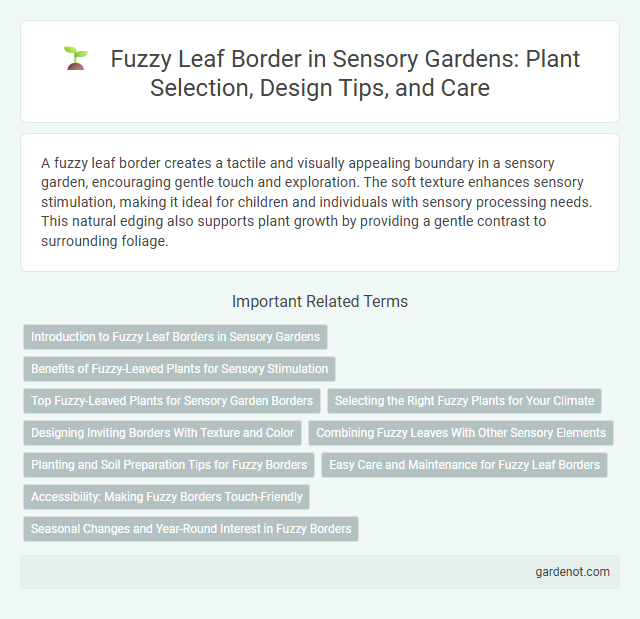A fuzzy leaf border creates a tactile and visually appealing boundary in a sensory garden, encouraging gentle touch and exploration. The soft texture enhances sensory stimulation, making it ideal for children and individuals with sensory processing needs. This natural edging also supports plant growth by providing a gentle contrast to surrounding foliage.
Introduction to Fuzzy Leaf Borders in Sensory Gardens
Fuzzy leaf borders in sensory gardens provide a tactile and visual experience, enhancing sensory engagement through soft, textured foliage that invites touch and curiosity. These plants, often characterized by fine hairs on their leaves and stems, help stimulate the sense of touch while contributing to the garden's overall sensory diversity. Incorporating fuzzy leaf borders supports inclusive garden design, making sensory gardens accessible and enjoyable for individuals with varying sensory preferences and needs.
Benefits of Fuzzy-Leaved Plants for Sensory Stimulation
Fuzzy-leaved plants enhance sensory gardens by providing tactile stimulation that engages touch and encourages exploration. Their soft, velvety textures soothe sensory receptors and promote relaxation, making the garden accessible for individuals with sensory processing challenges. Incorporating fuzzy leaf borders also adds visual interest through varied plant shapes and colors, enriching the multi-sensory experience.
Top Fuzzy-Leaved Plants for Sensory Garden Borders
Top fuzzy-leaved plants such as Lamb's Ear (Stachys byzantina), Dusty Miller (Senecio cineraria), and White Sage (Salvia apiana) create soft-textured, visually appealing sensory garden borders that invite tactile exploration. These plants are chosen for their dense, velvety foliage which provides a calming, sensory-rich experience while also demonstrating drought tolerance and low maintenance requirements. Incorporating fuzzy leaf borders enhances garden biodiversity by attracting pollinators and supporting beneficial insects.
Selecting the Right Fuzzy Plants for Your Climate
Selecting fuzzy plants that thrive in your climate ensures a vibrant and sustainable fuzzy leaf border. Consider species like lamb's ear (Stachys byzantina) for temperate zones, while selecting drought-tolerant varieties such as Artemisia for arid regions enhances resilience. Matching plant fuzziness and texture to local environmental conditions promotes healthy growth and year-round sensory appeal.
Designing Inviting Borders With Texture and Color
Fuzzy leaf borders enhance sensory gardens by introducing tactile and visual stimuli that engage visitors through soft, velvety textures and vibrant green hues. Incorporating plants like lamb's ear (Stachys byzantina) creates inviting boundary spaces that encourage touch and experiential interaction. These textured borders serve both aesthetic and functional purposes, guiding movement while enriching the sensory experience.
Combining Fuzzy Leaves With Other Sensory Elements
Fuzzy leaf borders create a tactile experience that enhances sensory gardens by inviting touch and exploration. Pairing these soft, textured leaves with fragrant herbs like lavender or rosemary intensifies both smell and touch perception. Incorporating vibrant flowers nearby also boosts visual stimulation, enriching the overall sensory engagement.
Planting and Soil Preparation Tips for Fuzzy Borders
Plant fuzzy leaf borders using well-draining soil enriched with organic compost to ensure moisture retention and nutrient availability for plants like lamb's ear (Stachys byzantina). Prepare the soil by loosening it to a depth of 12 inches to promote healthy root growth and incorporate mulch to maintain soil temperature and reduce weed competition. Regularly monitor soil pH, aiming for a slightly acidic to neutral range (6.0-7.0), to optimize plant health and fuzzy leaf texture.
Easy Care and Maintenance for Fuzzy Leaf Borders
Fuzzy leaf borders feature soft, textured foliage that requires minimal watering and thrives in well-drained soil, making them ideal for low-maintenance sensory gardens. Their natural resilience to pests and diseases reduces the need for chemical treatments, ensuring an eco-friendly and easy-care garden element. Regular pruning promotes healthy growth while maintaining the border's tactile appeal throughout the seasons.
Accessibility: Making Fuzzy Borders Touch-Friendly
Fuzzy leaf borders enhance sensory gardens by providing soft, tactile edges that accommodate visitors with visual impairments. The textured foliage promotes safe navigation while encouraging hands-on exploration, improving overall accessibility. Incorporating touch-friendly plants like lamb's ear ensures an inclusive experience for all users.
Seasonal Changes and Year-Round Interest in Fuzzy Borders
Fuzzy leaf borders enhance sensory gardens by offering dynamic seasonal changes through textures and colors that evolve throughout the year. Their soft, tactile foliage provides continuous year-round interest, stimulating touch and visual senses while supporting pollinators across seasons. These borders create an engaging sensory experience by blending evergreen and deciduous plants that shift in color, form, and texture with each season's progression.
Fuzzy leaf border Infographic

 gardenot.com
gardenot.com